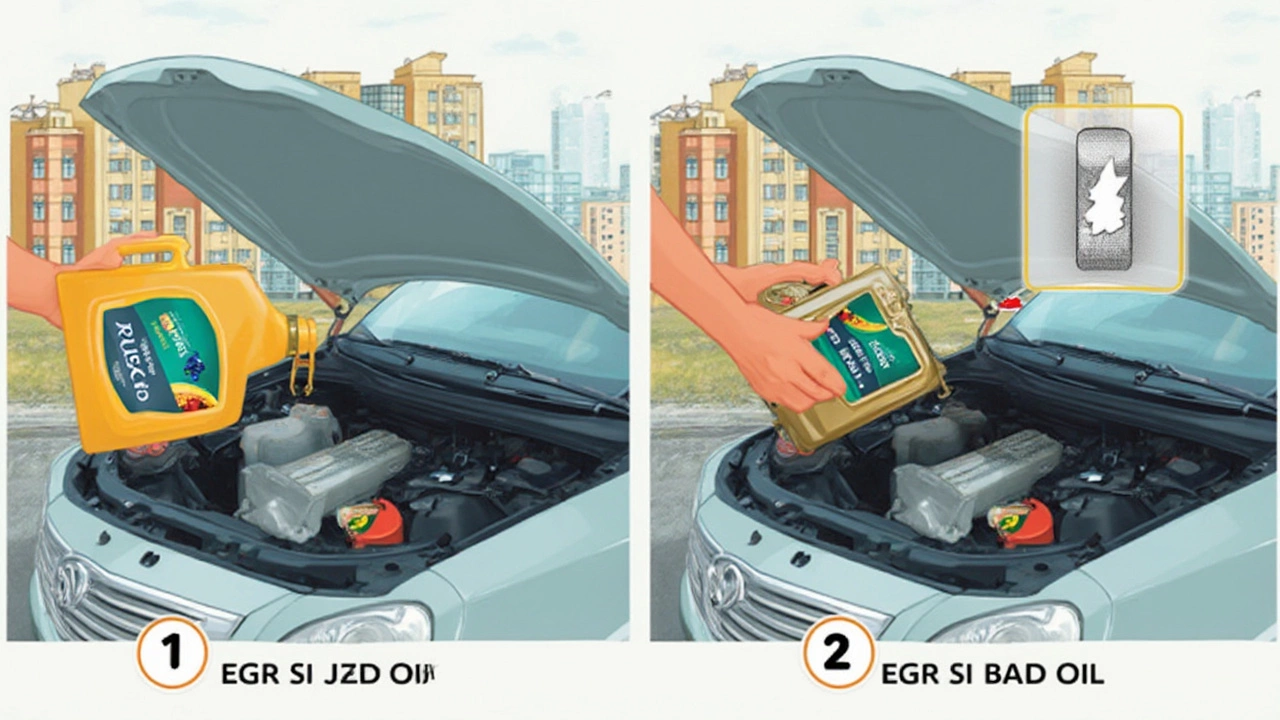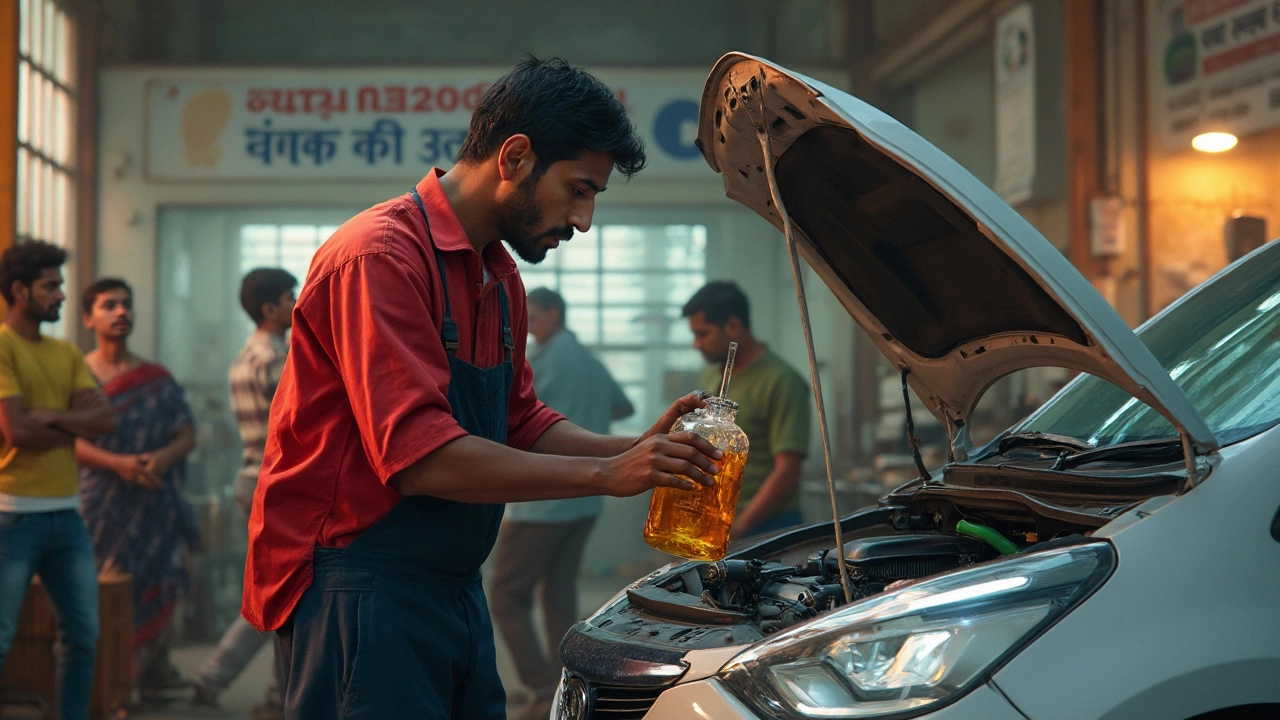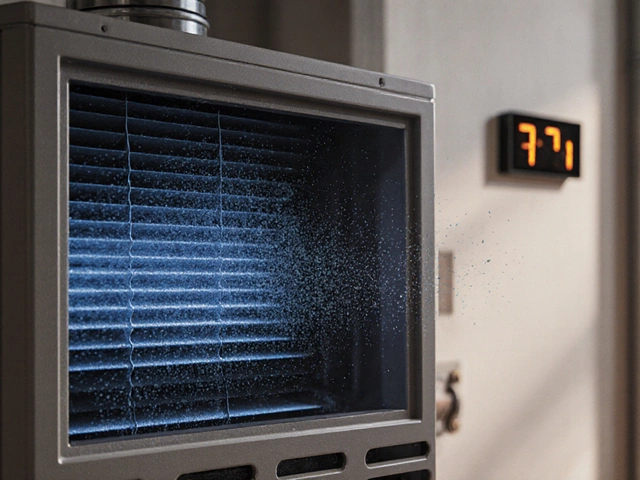Ever been low on oil and wondered if you could just pour some fresh stuff in, skip the hassle, and call it a day? Loads of drivers have done this in a pinch. It's quick, cheap, and you don't need a bunch of tools. But here’s the thing—topping off is not the same as swapping the old oil out completely.
Old oil can get dirty and loaded with sludge over time, especially if you’ve been driving a lot or your oil change schedule is a bit overdue. When you add new oil on top, you might be helping with the level, but you're not really fixing the bigger problem—your oil’s ability to keep your engine clean and running cool goes down fast when it’s full of grime. For most modern engines, clean oil isn’t just a luxury, it’s non-negotiable if you want to avoid surprise repairs.
So if your dipstick shows you’re running low and you’re in a bind, yes, topping off won’t hurt for the short-term. Still, it's not a real fix, and it won’t buy you much time. Ignoring dirty oil can lead to bad news: rough engine sounds, poor gas mileage, serious wear, and even breakdowns that’ll definitely blow your weekend plans (and your budget).
- What Happens When You Top Off Old Oil?
- Risks of Mixing New Oil with Old Oil
- How Much Old Oil is Too Much?
- When You Should Do a Full Oil Change
- Quick Checks: Signs Your Oil Needs Replacing
- Easy Oil Maintenance Tips
What Happens When You Top Off Old Oil?
Topping off isn’t the same as changing your oil. When you pour new oil into a motor that already has old, worn-out oil, both oils mix immediately. The fresh oil brings back some lost lubricating power, but it doesn’t magically make the dirty oil clean again. Your engine still runs on a blend of clean and grimy oil—imagine filling a dirty glass with fresh water and expecting it to taste perfect. It doesn’t work that way.
The real problem here is all the junk floating around in the old oil. Over time, dust, metal bits, and combustion leftovers build up, making the oil thick and less slippery. Because of this, your car’s moving parts work harder, which means more wear and tear. Adding new oil bumps up the level, but it doesn’t remove these troublemakers.
“Keeping engine oil clean and at the right level is one of the simplest, most effective ways to extend the life of your car’s engine.” — AAA Auto Repair Guide, 2023
If you’re tempted to just top off and go, check this out: studies show that oil with too much contamination loses up to 30% of its protective qualities. That means every mile gets tougher on your engine. Here’s a quick look at how topping off compares to a real oil change:
| Action | Removes Contaminants? | Cost (average) | Time Needed | Engine Protection Level |
|---|---|---|---|---|
| Topping Off Old Oil | No | $5–$10 | 5 minutes | Low |
| Full Oil Change | Yes | $30–$70 | 20–30 minutes | High |
The takeaway? If you’re in a jam, topping off can keep you rolling for a bit. But it doesn’t solve the underlying issue, so don’t put off a full change for long. Engine oil needs to be clean to really do its job—anything less just adds risk.
Risks of Mixing New Oil with Old Oil
Mixing new oil with old oil isn’t as harmless as it might seem. Sure, your oil level goes up, but most of the old stuff—the stuff with broken-down additives and bits of dirt—is still there. This leads to a few problems that are worth taking seriously if you want to avoid headaches later.
First off, dirty oil doesn’t do its job well. The old oil won’t clean or protect your engine like it should. When you pour in new oil, it just gets contaminated right away. So even though you’ve topped up, the gunk is still circulating, and that beats up critical engine parts over time.
The fresh oil also can’t “fix” the lost chemical properties in the old oil. Over time, engine oil loses essential additives—like detergents and anti-wear chemicals. When most of your oil is past its prime, you’re basically running on low protection, even if you add new stuff on top.
- Sludge buildup can speed up, especially if you keep topping off but skip real oil changes.
- Oil filters clog faster because they’re working overtime to trap grime from old oil.
- Engines can overheat due to thicker, dirtier oil not flowing well, especially in hot weather or stop-and-go traffic.
- Your fuel mileage drops, since dirty oil causes more friction inside your engine.
If you drive a car that uses synthetic oil, the risks go up because synthetics rely on advanced additives. Once those break down, topping off can't revive them.
So, while it’s easy to just pour in a little more and hope for the best, it’s not a solution. The best move? Change your oil on time and keep your engine oil fresh—not just topped up.
How Much Old Oil is Too Much?
Here’s the deal—if more than a quarter of your oil is old and dirty, you’re not getting much benefit from topping up. Your engine depends on having mostly clean oil in the system to prevent wear and tear. If most of what’s in your crankcase is old, dark oil, just adding a little fresh stuff on top won’t clean things up. Picture mixing a glass of muddy water with a splash of spring water and expecting it to look clean—it just doesn’t work.
Experts who work with engines daily say you shouldn’t make a habit out of topping off unless you recently had a full oil change and lost a tiny bit to a leak or burn-off. If your engine capacity is around five quarts and you add only half a quart, you’re probably fine for a short drive or an emergency. But if you’ve already gone more than 5,000 miles (especially with standard oil) or 7,500 miles for synthetic before you even consider adding more, the oil’s doing more harm than good.
Watch for these signs you’ve got too much old oil left:
- The oil looks gritty or black on the dipstick, even after adding fresh oil.
- Your oil feels thin, not slick, when you rub a little between your fingers.
- The engine makes more noise than usual, especially when starting cold.
- You notice a burning smell after driving—even short trips.
In these cases, it’s time to swap all that old stuff out. For engine oil, quality matters more than quantity. Running on mostly old oil for too long can clog tiny engine passages, mess with your oil filter, and cause damage that a basic top-off can’t fix. Save yourself a headache (and a fat mechanic bill) by sticking to full changes when most of the oil in your engine is past its prime.

When You Should Do a Full Oil Change
Knowing when to do a full oil change—and not just top off—is huge for keeping your engine happy and avoiding trouble on the road. Automakers usually recommend a full oil change every 5,000 to 7,500 miles for most newer cars, but that number isn’t written in stone. Some engines, especially if you drive a lot of short trips, tow heavy loads, or deal with stop-and-go traffic, need a fresh batch sooner. If you drive an older model or use conventional, rather than synthetic oil, stick closer to 3,000 miles.
Here are some no-nonsense signs it’s time to ditch the old oil and start fresh:
- You see “Change Engine Oil Soon” or the oil light on your dash.
- The dipstick shows dark, gritty, or sludgy oil.
- Your car sounds noisier than normal, especially when starting up.
- You smell burnt oil inside the cabin or under the hood.
- It’s been way too long since your last full oil change, according to your maintenance log or reminder sticker.
If you skip the full oil change, all that worn-out oil gets thick and loses its ability to protect engine parts. As a result, you could face nasty surprises: lower fuel efficiency, rough idling, or even engine damage that could come with a four-figure bill. Not worth risking for a quick shortcut.
Check out typical oil change intervals for different driving styles in this table:
| Driving Style/Condition | Recommended Oil Change Interval (Miles) |
|---|---|
| Mainly Highway | 7,000 – 10,000 |
| City, Stop-and-Go | 4,000 – 6,000 |
| Heavy Towing or Hauling | 3,000 – 5,000 |
| Short Trips (under 5 miles) | 3,000 – 5,000 |
| Older Cars (before 2008) | 3,000 – 5,000 |
The whole point of a full oil change is to get rid of old, contaminated oil and start your engine off right. When in doubt, don’t just pour new engine oil on top—swap it out entirely, and your engine (and wallet) will thank you.
Quick Checks: Signs Your Oil Needs Replacing
Not sure when your car needs an oil change? You don’t have to be a pro mechanic to spot the warning signs. Lots of these checks take only a few minutes but can save you from a ton of pain in the long run. Taking care of your engine oil is way easier than dealing with engine repairs down the road.
- Dark, dirty oil: Fresh oil is usually light brown or amber. If the oil on your dipstick looks really dark, gritty, or like old coffee, it’s loaded with grime and needs to go.
- Louder engine noise or knocking: If your engine suddenly sounds rough, noisy, or you notice weird ticking, your oil might be too dirty or thin to do its job.
- Check engine or oil warning light: When that little oil can lights up on your dash, don’t ignore it. This usually means your oil’s low, dirty, or both.
- Oil change mileage reached: Most cars need an oil change every 5,000 to 7,500 miles with modern synthetic oil, but always double-check your manual.
- Exhaust smoke: Notice blue or dark smoke coming out the back? That can signal dirty oil or something much worse inside the engine.
If you want a quick cheat-sheet, check out this table for common oil warning signs and what they probably mean:
| Sign | What It Might Mean | Action To Take |
|---|---|---|
| Oil looks black/gritty | Full of dirt, lost its cleaning power | Schedule an oil change soon |
| Engine noise is louder | Oil's too thin or too old | Check oil, change if needed |
| Oil light on dashboard | Oil's low or pressure is off | Check dipstick & add/change oil |
| Mileage past oil change interval | Oil quality dropped | Swap the oil ASAP |
| Exhaust is smoky | Possible oil burning | Get checked by a mechanic |
Don't forget: If in doubt, pop the hood and pull the dipstick. Wipe it clean, stick it back in, then pull it out again and see what the oil really looks like. That's your best quick test when things just don't sound or feel right.
Easy Oil Maintenance Tips
Keeping your engine healthy doesn't have to be complicated or time-consuming. A little effort now can save you a world of headaches down the road, especially when it comes to engine oil.
- Check your oil every month. It's simple: pull out the dipstick when your engine is cool, wipe it off, put it back in, and see where the oil level hits. If it looks clean and reaches the "full" mark, you're good. If it's dark, gritty, or low, it’s time for action.
- Stick to your car's oil change schedule. Most manuals suggest every 5,000-7,500 miles if you're using synthetic, and closer to 3,000-5,000 for conventional oil. Newer cars sometimes go longer, just check your owner's guide.
- Watch for oil leaks under your vehicle. Even small puddles can add up to big problems. If you spot a fresh stain on your driveway, it's usually a sign to check your oil or visit a mechanic.
- Use the right oil. Not all oil is the same. Always check your manual for the right viscosity (the numbers like 5W-30) and whether you should be using synthetic or conventional.
- Change your oil filter when you change your oil. Dirty filters mess with oil flow and let junk back into your engine. Filters are cheap — don’t skip this.
Here’s a handy snapshot to help you remember when to check or change your oil, based on what kind of driver you are:
| Driver Type | Oil Check Frequency | Oil Change Interval |
|---|---|---|
| Daily commuter | Once a month | 5,000-7,500 miles |
| Short trips/cold climate | Every 2 weeks | 3,000-5,000 miles |
| Long distance/highway | Once a month | 7,500-10,000 miles |
| Sporadic driver (weekends only) | Every 2 months | At least twice a year |
If you ever notice your oil looking milky (a sign of coolant mixing with oil), smelling burnt, or your engine running hotter than normal, don't wait — those are warning flags. Keeping an eye on your oil is just as important as filling up your gas tank. Get your kids to help, too — engine checks are some of the life skills I’m teaching Finneas before he even gets close to driving age.




